With the approval of the fiscal year (FY) 2023 National Defense Authorization Act, Congress and the President expanded the Navy’s official role. Now, in addition to warfighting, they acknowledge what has been fact since the American Revolution: that the Navy’s mandate includes “the peacetime promotion of the national security interests and prosperity of the United States.”REF Given the scale of the threat from China, it is becoming apparent that a new fleet construct is required to optimize peacetime competition and prepare for major conflict.
Today at sea, China is competing to overturn the norms governing commerce and naval operations to its benefit—a rules-based re-orderingREF—with far-reaching implications for the United States’ security and prosperity. To counter this, the Navy should better organize its forces and headquarters. Instead of ordering the fleet by combatant commands, the Navy should re-organize its several fleets by maritime geography and add at least one fleet focused on operations in the South China Sea.
Reorganizing for Great-Power Competition with China
According to a government-sponsored December 2022 RAND Corporation report, China is planning a network of bases that can support global military operations.REF China has already successfully eroded the rules-based orderREF in the South China Sea, waging a so-called maritime insurgency using maritime militia to reset the norms there to China’s liking.
At the same time, China has effectively used economic statecraft, military presence, and elite capture to secure favorable policies overseas. Most notable in 2022 was an agreement with the Solomon Islands opening the way for a Chinese security presence and construction of a presumed naval base in Cambodia. Less successful was an attempt at a naval base in Equatorial Guinea—but China’s aspirations have not slowed.
Academic analyses, regional reporting, and official documents all indicate that China’s challenge is evident and growing—most recently over access in the strategically important Pacific island nation of Vanuatu.REF The last annual Defense Department report on China doubles down on these assessments, making clear that China is intent on building a global naval force that could imperil U.S. interests if not addressed.REF While the threat is real, it is important to understand that China’s military is limited, meaning that America can contest its overseas aspirations.
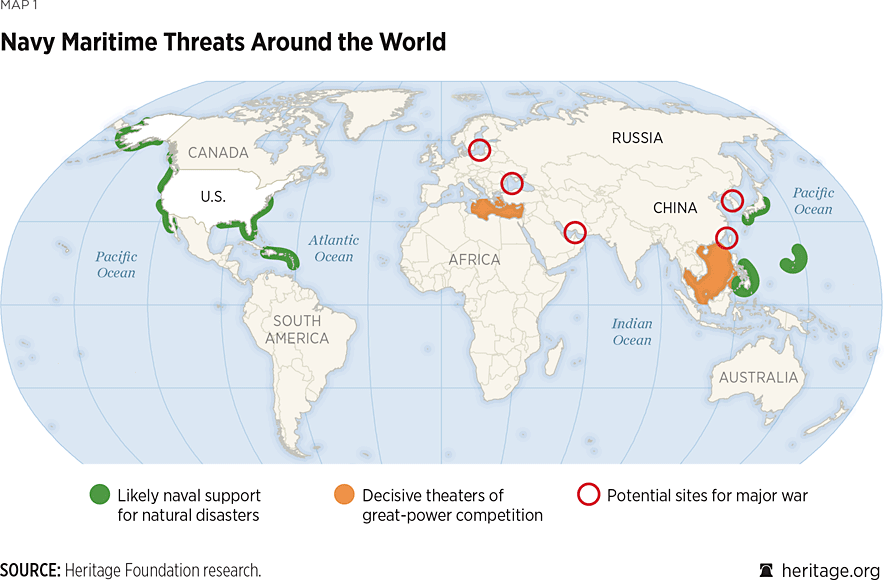
Naval theorist Julian S. Corbett, in his 1911 book Some Principles of Maritime Strategy, stressed navies’ role in controlling “maritime communications.” Today this concept would include seaborne trade, undersea cables, transoceanic airborne commerce, and naval operations.REF A reorganization of the U.S. Navy’s numbered fleets as laid out in this report would focus and tailor U.S. forces on executing a peacetime maritime strategy while better preparing for possible war. Since the release of the 2018 National Defense Strategy (NDS), including the 2022 update, the Navy has failed to adapt to the new strategic focus on competition with China.
The principal unit for executing sustained naval operations in peacetime and war are numbered fleets. There are six numbered fleets today that are aligned to joint geographic regions (e.g., European Command, Africa Command, etc.). However, given the paucity of warships and scale of the threat, it is inescapable that the Navy should reorganize to better focus and tailor forces for the greatest strategic effect. This is well past due given events in the South China Sea, which has seen increasingly aggressive Chinese actions.REF
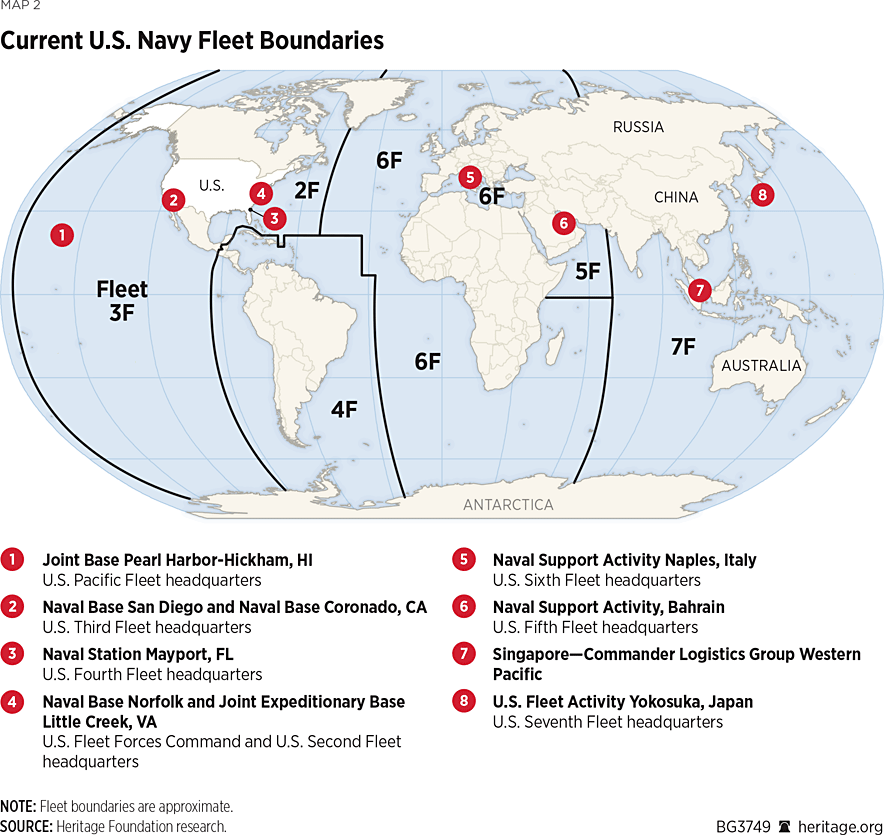
Today these numbered fleets are aligned to six geographic joint combatant commands, such as Central Command headquartered in Florida but responsible for military operations in the Middle East. Recent numbered-fleet changes include standing up the Fourth FleetREF in 2008 and re-establishing the Second FleetREF in 2018. The former was intended to facilitate regional collective maritime structures in line with the Navy’s 2007 Cooperative Strategy for 21st Century Seapower. The establishment of the Second Fleet, however, was in response to a series of troubling Russian submarine operations off the U.S. eastern seaboard. Given Chinese encroachment in the South China Sea on U.S. interests—including threats to American alliances and trade in the region—calls have been made to re-establish a fleet focused on that region most notably by the Secretary of the Navy in 2020.REF
A Global Maritime Campaign Is Best Executed Using Regional Numbered Fleets
The 2022 NDS makes clear that the United States is engaging in a comprehensive competition with China. The Administration’s approach is based on a concept called “integrated deterrence,” which involves inter-agency and joint and combined campaign plans to influence and deter China.REF This competition and associated campaign plans will necessarily have a strong maritime component given the global aspirations of the Chinese Communist Party and its military focus on Taiwan.REF Organizing the Navy’s numbered fleets along a maritime focus instead of the current landward geographic focus—with forces tailored to specific regional strategic missions—is one way to better do this.
The allocation of forces is normally based on requests from the joint geographic combatant commands through an annual Global Force Management (GFM) process.REF This necessarily prioritizes risks within—and not across—joint commands connected by the ocean, a prime example being three joint commands (AFRICOM, CENTCOM, and INDOPACOM) responsible for the Indian Ocean. This situation makes it more likely that demands on the Navy are excessive and not strategically coherent.REF Short of an unlikely change to the joint force architecture, modification of the GFM process and reorganization of numbered fleets has a better chance of success to improve naval force strategic efficacy.
By using an oceans-informed force allocation—instead of a joint geographic combatant command—it is possible to assign naval forces according to maritime regions, such as the Indian Ocean or South China Sea. Another region ripe for rethinking numbered-fleet organization is a stretch of ocean connecting the Caribbean and the Gulf of Guinea through which piracy and illegal activity frequently transit—a region covered by both Southern Command headquartered in Florida and Africa Command headquartered in Germany with the associated Sixth and Fourth Fleets. Combining the operational needs in geographically contiguous maritime regions would allow a single fleet to best address strategic needs coherently—such as illegal maritime activity, port access, partner nation maritime capacities, and Chinese and Russian influence. The same is true in the Indian Ocean covered today by Fifth, Sixth, and Seventh Fleets, which should likewise be consolidated into a single fleet to deter and confront Iranian aggression and enable greater cooperation with India that can confound the growing Chinese military presence in the region.REF However, doing so would alter the existing relationships among joint commands, such as European Command and its associated naval component command—Naval Forces Europe and Africa.
Each joint geographic combatant command has an associated naval component command—for instance, Indo–Pacific command has Pacific Fleet. This arrangement assists the joint command’s control over naval forces assigned it and likewise allows the Navy’s component command to inform and shape the joint command’s requirements for naval forces. Changing the geographic coverage of the numbered fleets would not impact component commands’ role, but it would better inform and likely improve coverage of joint command requests.
This new arrangement would also strengthen readiness and maintenance planning. For example, a newly constituted fleet in Southeast Asia would be better able to access new ports for maintenance of deployed vessels. It would also be better positioned to plan increasingly effective bilateral exercises. Such responsibilities are today held by the Seventh Fleet, located almost 3,000 miles away in Japan with numerous competing demands.
Already the Navy is making some adjustments to global great-power competition with China. In late 2020, the expeditionary sea-base Hershel Williams was home-ported on the Greek island of Crete and dedicated to missions in Africa. The ship is now conducting routine deployments to the Gulf of Guinea and supporting the multinational Africa Command exercise Obangame Express.REF Southern Command, dedicated to operations in South America, has also seen increased Russian and Chinese activity in recent years. This led Congress to include in the FY 2023 defense budget a requirement to study basing up to six littoral combat ships there with Fourth Fleet.REF However, the most consequential change would be to bolster naval presence and organization in the South China Sea.
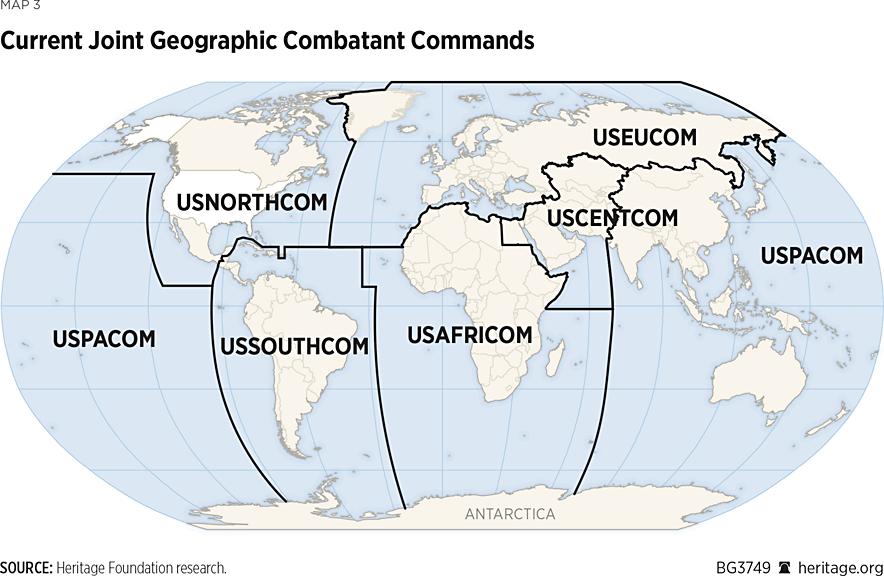
New Fleets Needed for Contested and Strategically Vital Maritimes
Southeast Asia has been a focal point of great power competition before and is once again an area of dispute between the United States and China; modest moves by the Navy there are setting the stage for future growth. Notable is the return of littoral combat ships rotational deployments to Singapore, joining logistics ships such as expeditionary fast transports (EPF) that doubled as a Seventh Flag Ship in 2018.REF However, these deployed ships lack a regionally focused operational staff, instead relying on Seventh Fleet’s Logistics Group Western Pacific responsible for the entirety of the fleet’s needs under the command of a one-star admiral based in Singapore.REF
How to Resource These Changes. Organizational changes envisioned in the associated tables and graphics can be achieved without congressional modification to the Goldwater–Nichols Act nor require presidential action to adjust the Unified Command Plan.REF Establishing new numbered fleets based overseas, however, would require congressional notification at a minimum.
The Navy could accomplish these changes starting from the Singapore-based destroyer squadron and repurposing an existing ship in the region, such as an Expeditionary Fast Transport, as the new fleet’s command ship. A three-star admiral should lead this fleet to bolster its resourcing and access to regional naval leaders and to signal the significance of the region to U.S. interests.
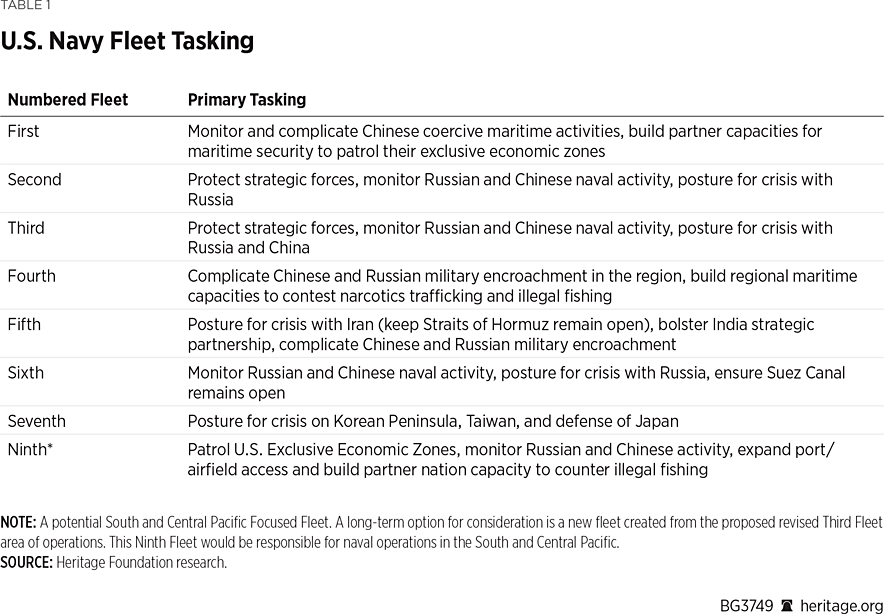
One option that does not require expanding the number of admirals is to merge the recently created N7 office in the Pentagon back into N3/N5, freeing a three-star admiral for operational command of a fleet. Sending senior flag officers to operationally important commands in key contested regions is a move Congress would likely support.
In the long term, a potential second new numbered fleet could be created focusing on the increasing maritime competition in the South and Central Pacific.REF
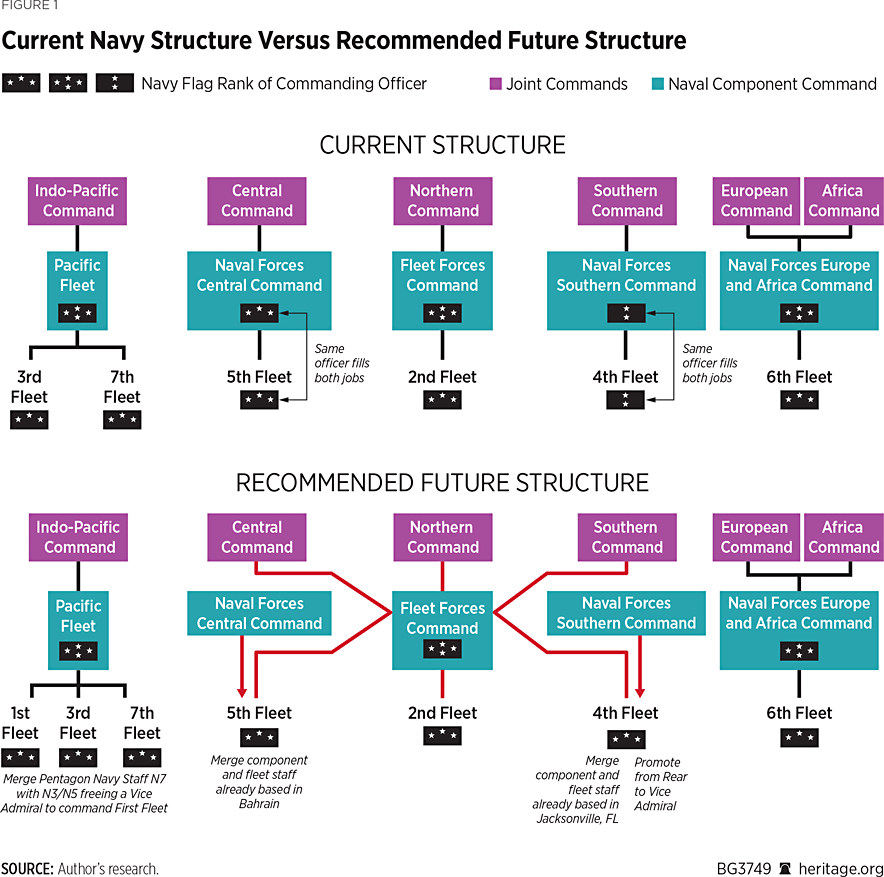
Recommendations
To shift the allocation of naval forces to a numbered fleet–centric construct, the following phased approach is recommended:
- The Secretary of Defense should direct the chairman of the Joint Chiefs of Staff to amend the GFM processes, stipulating that naval forces be allocated to numbered fleets based on operational requests of the joint geographic combatant commands.
- The chief of naval operations, in concert with the chairman of the Joint Chiefs of Staff and the Geographic Combatant Commanders, should adjust the numbered-fleet areas of responsibility as indicated in the above map and table.
- Once this change is initiated, Congress should require the Department of the Navy to provide an annual report on the transition to this new fleet-centered approach. This report should include the number of requests for forces by joint commands and which numbered fleet provided those forces. Such reporting can help Congress assess whether the resourcing needed to balance operational loading and procurement is informed by the most effective composition of forces for day-to-day and crisis operations.
Conclusion
Centering the global maritime competitive arm of the NDS on the numbered fleets makes sense from an operational standpoint: Numbered fleets are organized for sustained maritime operations. However, achieving the full benefit of this requires reorganizing the numbered fleets according to narrow strategic objectives bounded by commonsense geography of the maritime.
Brent D. Sadler is Senior Research Fellow for Naval Warfare and Advanced Technology in the Center for National Defense at The Heritage Foundation.



